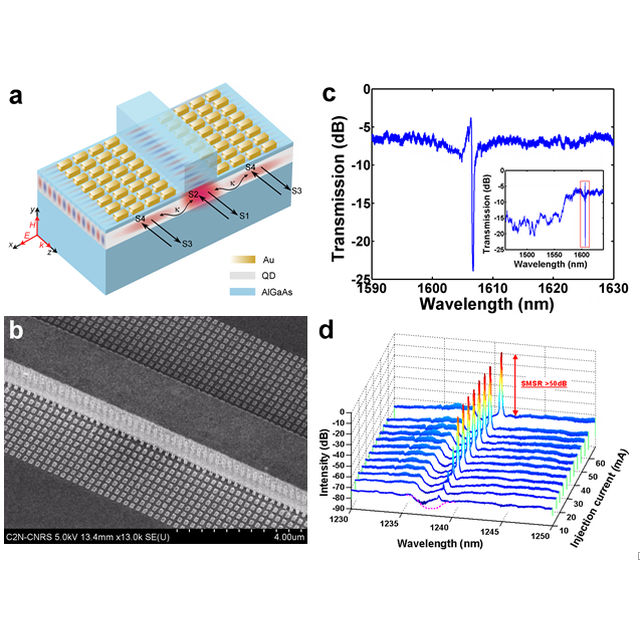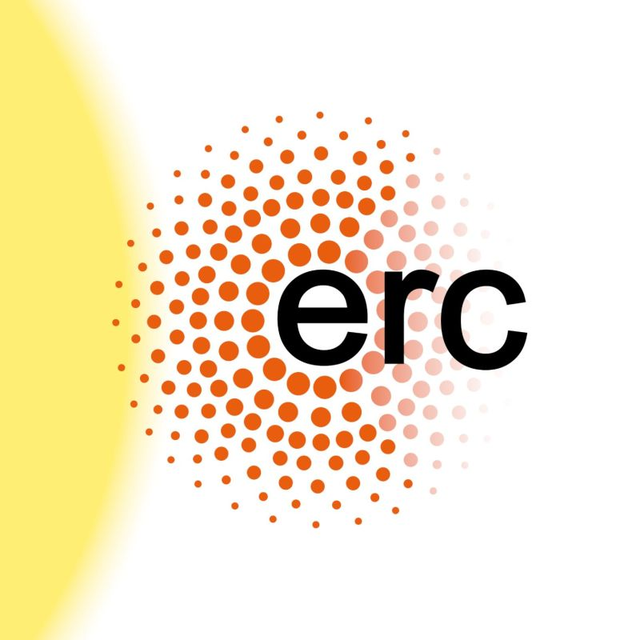Researchers at the Centre de Nanosciences et de Nanotechnologies (C2N), in collaboration with Laboratoire Charles Fabry (LCF) and Telecom SudParis proposed to use a 2D metamaterial Bragg grating assisted waveguide to achieve Electromagnetically-Induced-Transparency (EIT) resonance with an ultra-high Q~5000 and contrast >20dB. This concept was further applied to the demonstration of single frequency emission electrically injected distributed feedback (DFB) lasers in the NIR telecom domain. The ability of metamaterials to shape lasing properties with EIT - based low losses light propagation opens promising perspectives that such types of lasers may present increased robustness with respect to parasitic optical return which constitutes one of the major impairments of DFB lasers in telecommunications applications.
Metamaterials (MMs) exploit the emerging properties of an array of individual elements displaying some kind of resonance, with the scope of producing artificial photonic responses absent from normal materials. The form of a 2D array commonly designated as “metasurfaces” has often been considered for obvious feasibility reasons, with basic features such as near-normal incidence transmission/reflection exhibiting a host of new effects. The popular word of “metasurfaces” commonly refers to the most of such 2D arrays. Waveguides (WGs), which are a privileged vehicle of functional photonics, have also been considered with MMs. However, since metallic/plasmonic structures often constitute the elementary MM resonators, the incurred losses, to which guided modes are quite sensitive, have been a substantial hurdle to the achievement of convincing and broad-reaching demonstrations.
In a work published in May 2024 in Advanced Functional Materials journal, a team of researchers at the Photonics Department of the Centre de Nanosciences et de Nanotechnologies – C2N (CNRS/Univ. Paris-Saclay) in collaboration with the Laboratoire Charles Fabry– LCF (CNRS/Univ. Paris-Saclay), and Telecom SudParis reported the observation of a marked Fano type EIT effect with record high quality factor of resonance: Q~5000 and contrast >20dB in metamaterial Bragg grating (MMBG) assisted passive WGs. This supports the idea that MMs, as functional photonic building blocks, can lead to low losses in many standard devices if properly designed. Unlike any standard metal grating, MMBG assisted WGs exhibit both strong grating coupling strength and low-loss properties simultaneously. This concept is further applied to the demonstration of single frequency emission electrically injected DFB lasers in the NIR telecom domain. The key point is that laser emission occurs at the peak of EIT, i.e. the maximum in transmission.
It addresses in this way one of the main critical issues of DFB lasers related the single frequency yield. The laser performances are at the state-of-the art (Ith<20mA, Pmax>23mW at I=200mA, side mode suppression ratio >50dB, enhanced polarization selectivity > 10dB, tolerance to optical feedback > -21dB compliant with IEEE 802.3 standard without an isolator). The presented approach is compatible with existing industrial technologies and promising for large scale real-life telecom applications. Such highly coherent laser sources are indeed required in diverse applications as coherent communications, sensing, programmable photonic circuits.
Figure 1a represents the principle of MMBG with EIT arising from physically separated resonant contributions, nevertheless sensed as a whole by the waveguide mode. The fabrication and characterization of the experimental structure (see Figure 1b), were performed at C2N*, charecterization by C2N and Telecom SudParis, while design and modeling were carried out by C2N* and LCF partners.
The experimental transmission spectral response represented in Figure 1c for a 3.2 mm long MMG ridge waveguide shows the presence of a marked EIT at 1607 nm. As can be seen, the peak value of transmission is more than 2 dB higher with respect to the WG transmission level outside the EIT resonance. The high-contrast narrow transmission band may provide an advantage toward more robust single-frequency operation of DFB lasers. To prove the validity of the present flavor of EIT concept, the same heterostructure that served for the passive MMBG WG study was also used for the fabrication of an “EIT laser” with an emission wavelength around 1.24 µm.
The emission spectra for a MMBG laser at different injection currents are shown in Figure 1d. They display a clearly visible EIT feature, especially when the injection current is below the threshold, which is around Ith =21 mA. The laser emission line grows exactly at the sub-threshold local emission maximum, emerging within a few nm wide dip attributed to the MMBG. The laser emission is single frequency with a side mode suppression ratio greater than 50 dB up to the largest current (I ~ 3Ith).
*In the C2N Technology Facility (cleanroom), member of the French network of large high-end facilities (RENATECH CNRS)
References
Electrically injected metamaterial grating DFB laser exploiting an ultra-high Q electromagnetic Induced Transparency resonance for spectral selection.
N. Dubrovina1, Y. Liang1, Q. Gaimard1, V. Brac de la Perrière1, K. Merghem1,2, H. Benisty3, A. de Lustrac1,4, A. Ramdane1, A. Lupu1
Advanced Functional Materials, 2024, 34 (45), 2405912.
https://doi.org/10.1002/adfm.202405912
1 Centre de Nanosciences et de Nanotechnologies (CNRS, Université Paris-Saclay)
2 Telecom SudParis, Institut Polytechnique de Paris, 91120 Palaiseau, France
3 Laboratoire Charles Fabry de l’Institut d’Optique, CNRS, Univ. Paris Saclay
4 LEME, UPL, Univ Paris Nanterre, Ville d'Avray, F92410 France
Figure 1: (a) Sketch of the dielectric ridge waveguide assisted by MM Bragg grating. The arrows S1 and S2 represent the two counter-propagating modes of the ridge waveguide. The arrows S3 and S4 represent the fundamental plasmonic supermode of the MM grating. Their profiles (blue/red/brown) are visible on the different cuts., (b) SEM view of gold cut-wires MMG and III-V passive semiconductor waveguide. (c)Transmission spectrum of a 2 µm wide and 3.2 mm long MMG ridge waveguide in the EIT region. The inset shows the spectral response at extended wavelength range. The red box indicates the EIT region. (d) Emission spectra of 1.68 mm long laser waveguide structures at dufferent injection currents.
*In the C2N Technology Facility (cleanroom), member of the French network of large high-end facilities (RENATECH CNRS)
Contact C2N : Anatole LUPU









